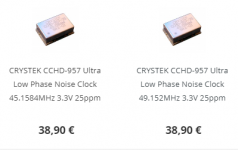Hi,
I'm looking at placing an order for the Ian Canada Fifo Q3, Transporter, and super capacitor Pi filter. At the same time, I am looking to order upgraded clocks.
I was hopeful someone may be able to clarify what clock speeds are required for the upgrade. I.e. do I order the same clock speeds, do I need to mix and match etc.
Example Clocks:
CRYSTEK CCHD-957 Ultra Low Phase Noise Clock 49.152MHz 3.3V 25ppm - Audiophonics
CRYSTEK CCHD-957 Ultra Low Phase Noise Clock 45.1584MHz 3.3V 25ppm - Audiophonics
Fifo Q3:
IAN CANADA FIFOPI Q3 ULTIMATE FIFO Reclocker Module PCM 32bit 768kHz DSD1024 DoP - Audiophonics
The manual doesn't seems to cover this, unless I missed it.
@iancanada, it would be amazing if some kits existed which would allow novice users to buy the correct boards with a pre punched case. I think this would go a big way to helping users like me get off the fence and purchase.
I'm looking at placing an order for the Ian Canada Fifo Q3, Transporter, and super capacitor Pi filter. At the same time, I am looking to order upgraded clocks.
I was hopeful someone may be able to clarify what clock speeds are required for the upgrade. I.e. do I order the same clock speeds, do I need to mix and match etc.
Example Clocks:
CRYSTEK CCHD-957 Ultra Low Phase Noise Clock 49.152MHz 3.3V 25ppm - Audiophonics
CRYSTEK CCHD-957 Ultra Low Phase Noise Clock 45.1584MHz 3.3V 25ppm - Audiophonics
Fifo Q3:
IAN CANADA FIFOPI Q3 ULTIMATE FIFO Reclocker Module PCM 32bit 768kHz DSD1024 DoP - Audiophonics
The manual doesn't seems to cover this, unless I missed it.
@iancanada, it would be amazing if some kits existed which would allow novice users to buy the correct boards with a pre punched case. I think this would go a big way to helping users like me get off the fence and purchase.
Attachments
Last edited:
The manual does actually cover it, please see pages 7 and 8.
DocumentDownload/FifoPiQ3UltimateManualV3.0.pdf at master * iancanada/DocumentDownload * GitHub
DocumentDownload/FifoPiQ3UltimateManualV3.0.pdf at master * iancanada/DocumentDownload * GitHub
Ok, thanks. I clearly need to look more thoroughly next time.
1. Is there a clock combination that sounds better?
For example does 45.1584 sound better than 90.3168? etc
49.1520 MHz V's 98.3040 MHz.
2. Do the clocks simply plug in and out, like an Opamp?
Of do they require soldering?
For instance this clock:
ACCUSILICON AS318-B-903168 Ultra Low Jitter Clock 90.3168MHz - Audiophonics
Thanks
1. Is there a clock combination that sounds better?
For example does 45.1584 sound better than 90.3168? etc
49.1520 MHz V's 98.3040 MHz.
2. Do the clocks simply plug in and out, like an Opamp?
Of do they require soldering?
For instance this clock:
ACCUSILICON AS318-B-903168 Ultra Low Jitter Clock 90.3168MHz - Audiophonics
Thanks
Last edited:
The choice mostly depends on which sample rates you want to play. I believe that for the crystal clocks for example the lower frequency clocks might have a bit better phase noise performance, but I doubt you will hear much of a difference, if any.
The clocks should be "plug in and out" as long as they are DIP14 package. I believe the accusilicons you linked are DIP14, but please confirm that. The crystek on the other hand is SMT and will have to be soldered on an adapter board.
The clocks should be "plug in and out" as long as they are DIP14 package. I believe the accusilicons you linked are DIP14, but please confirm that. The crystek on the other hand is SMT and will have to be soldered on an adapter board.
Thanks for the reply, I appreciate your thoughts.
I just wonder if I would hear any difference between this proposed setup and running USB direct from the RPI4 to my RME ADI 2 FS DAC.
In my experience the RME ADI2 FS provides excellent jitter and noise rejection, so I just don't know if there is further improvement to be had. Adding up all the boards and clocks, the cost gets up there in $Aud.
I would also lose DSD playback rates. I guess I could use the Bridge Pi, but that seems counter intuitive when I have a DAC with such a superior USB implementation.
I just wonder if I would hear any difference between this proposed setup and running USB direct from the RPI4 to my RME ADI 2 FS DAC.
In my experience the RME ADI2 FS provides excellent jitter and noise rejection, so I just don't know if there is further improvement to be had. Adding up all the boards and clocks, the cost gets up there in $Aud.
I would also lose DSD playback rates. I guess I could use the Bridge Pi, but that seems counter intuitive when I have a DAC with such a superior USB implementation.
